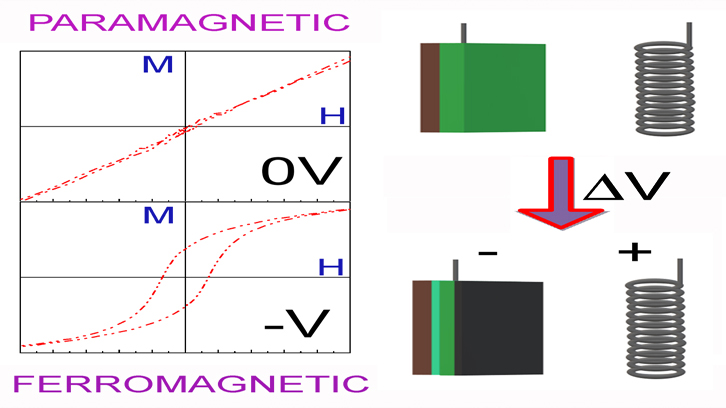“Magnetic switch”, induction or suppression of ferromagnetism through electric voltage

In this digital age, society is characterized by generating and managing massive amounts of information. Energy consumption associated to information and communication technologies reached, already in 2012, a 4.7% of the total energy produced. With an increase in the total amount of information generated, it is expected that the total fraction of energy consumed increases dramatically. This is the reason why the development of low-power technologies is becoming increasingly necessary. There are several proposals to address this problematic situation. One of the most promising ones is the magnetic manipulation through electric fields. This methodology is interesting because it drastically reduces the use of electric current and consequently, it minimizes the energy losses caused by the Joule heating effect.
When an electric field is applied to a magnetic material, different phenomenologies can occur. Recently, it has been observed that, under the application of an electric field, the magnetic properties of a layer can be altered due to the controlled diffusion of oxygen (this phenomenon is called “magneto-ionics”). Therefore, materials whose ion mobility is particularly notable are used, such as hafnium oxide or gadolinium oxide. This method, contrary to the accumulation of electrostatic charges or the effects of conventional magneto-elastics, allows non-volatile modifications of magnetism meaning that after removing the electric field, the magnetic material does not recover its initial state. Although this method is very promising, in most cases, the experiments have been perfomed at temperatures above the ambient temperature in order to increase the kinetics of the diffusion processes, which is otherwise exceedingly slow.
In a paper recently published in the ACS Nano journal, led by the researchers from Universitat Autònoma de Barcelona (Alberto Quintana, Enric Menéndez, Eva Pellicer and Jordi Sort, the last one also being an ICREA researcher) and in collaboration with several national and international groups, the authors have proved the possibility of inducing ferromagnetism at ambient temperature in a layer of 100 nm made of Co3O4 (paramagnetic at ambient temperature and antiferromagnetic at low temperatures) due to the controlled diffusion of the oxygen present in the oxide. In other words, this phenomenon is observed without using donors/sinks of oxygen such as hafnium oxide or gadolinium oxide through the application of voltage trough an electrolyte. The authors of this paper take advantage of the formation of an electric double layer which, due to its reduced thickness (1 nm), allows electric fields to be obtained above 100 MV/cm. The process proves to be reversible on a magnetic, structural and compositional level, at ambient temperature (the observed changes can be reverted in a controlled manner through voltage of inverse polarity). This results in a “magnetic switch” controlled by electric voltage. Moreover, the authors prove the complexity of the diffusion process through the characterization of the defects present in the material through the use of techniques such as positron annihilation spectroscopy.
Faculty of Sciences
Universitat Autònoma de Barcelona
References
Quintana, A., Menéndez, E., O. Liedke., M., Butterling, M., Wagner, A., Sireus,V., Torruella, P., Estradé, S., Peiró, F., Dendooven, J., Detavernier, C., D. Murray, P., Allen Gilbert, D., Liu, K., Pellicer, E., Nogues, J and Sort, J. (2018). Voltage-Controlled ON–OFF Ferromagnetism at Room Temperature in a Single Metal Oxide Film. ACS Nano, 12 (10), 10291-10300. DOI: 10.1021/acsnano.8b05407.

